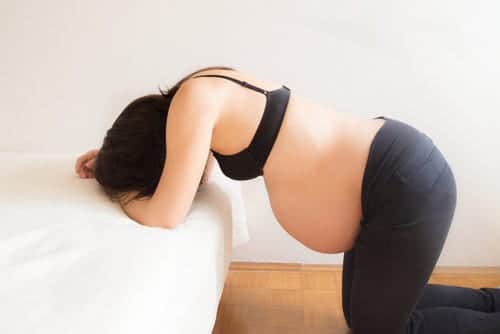Factsheet – Managing labour: Mood, Mobilise and Munch (part 3 of 3)
Trixie McAree
Professor of Midwifery and Maternal Health, Birmingham City University
@mcareetrixie (Twitter)
Summary
Birth is a physiological process that shows we are alive, other signs of life include eating (nutrition), excretion and breathing. However, it would seem that we struggle more with birth than any of the other elements of life.
In 2017/18, 52.2% of women commenced labour spontaneously, with 57% of women giving birth spontaneously1, as opposed to requiring either instrumental or caesarean interventions for birth. This suggests almost half of births require additional external intervention, giving rise to the question: What can we do to support our bodies doing what they was designed to do and give birth in the healthiest way possible?
Although there are no guarantees for an easy labour this factsheet series explores three keys to physiological labour where potentially harmful or unnecessary intervention is kept to a minimum. They are managing your mood, mobilising prior to and during labour and munching throughout labour. This factsheet looks at munching – eating and drinking in labour to support normal physiological processes.
Link to free flow article: How to have a positive birth
What we know
Eating and drinking in labour is a controversial topic, where you will meet a wide range of views, both in the literature and in hospital. When talking about eating and drinking in labour, this means a light/moderate diet and drinking to quench thirst. Labouring women report generally not wanting to eat huge amounts but eat for comfort and energy, according to how they feel. Eating what you want, as you want gives a sense of wellbeing and control, and women report liking the freedom to choose whether they eat or not.2
The body needs glucose in order to labour3 and in fact being in labour is similar to running a marathon2 in terms of calorific demand. Therefore eating in drinking can be helpful – to help the body function properly.
The best way to weigh up evidence is by doing a meta-analysis, which gathers all data together and draws conclusions. The most respected of these – The Cochrane review, 20134, concluded that eating or not during labour did not make a difference to outcomes, either positive or negative however the reviewers did not assess how it made women feel. If a woman feels uncomfortable about eating and drinking in labour her anxieties will be heightened. Women have reported that having restricted diet intake increases stress levels5 making it harder to labour. In addition some of the studies included were very prescriptive about what birthing people ate during the study which may have influenced the outcome of the study.
However a more recent meta-analysis6 suggested that labour was significantly shortened when women eat and drink.
In order to make a decision about whether you want to eat or drink you need to understand the history of this topic and why many maternity hospitals still restrict oral intake during labour regardless of what their guidelines say.
Concern about eating in labour was first raised 1946. At this time, childbirth was gradually moving into a hospital setting and caesarean section was becoming more available. Mendelson, an obstetric cardiologist reported that eating and drinking in labour was dangerous because if a general anaesthetic was required a woman risked inhaling the contents of her stomach into her lungs as she was anaesthetised (causing muscle including oesophageal paralysis). His paper reported that two women died in these circumstances, bearing in mind that aesthesia was a new discipline at this time. The Mendelson paper has continued to influence clinical practice until the present day where many labour wards still discourage women from eating and drinking in labour, despite World Health Organisation recommending not restricting eating and drinking unless there is a good reason.
Moving on today, NICE guidance since 2007 has been to:
“Inform the woman that she may eat a light diet in established labour unless she has received opioids or she develops risk factors that make a general anaesthetic more likely. [2007”].
Therefore our first consideration is to understand why the advice has been set out this way. The reason not to eat after having opioids is that they (usually pethidine) have the side effect of making the recipient feel very nauseous sometimes to the point of vomiting, which is why they are often given with an anti-emetic (a drug that reduces nausea and vomiting). Therefore it is possible you may vomit when eating in those circumstances. However, as unpleasant as this may be, it is not dangerous.
General anaesthetic is used rarely, (rates vary according to location). Where women already have an epidural in situ, and then require an emergency caesarean section they are unlikely to need a general anaesthetic as the epidural simply needs topping up. If you don’t have an epidural you but need an emergency caesarean the preferred mode of anaesthetic is still epidural or spinal rather than a general anaesthetic. To provide further reassurance, if a woman unexpectedly needed a general anaesthetic there are measures that can be taken to prevent regurgitation. This approach is taken, for example, if a person had been in an accident immediately after eating dinner and needs immediate surgery. The surgical team can do what is called cricoid pressure (or Selleck manoeuvre) which is an effective way of preventing any regurgitation.7
The incidence of aspiration in Caesarean section under general anaesthesia is 1 in 400–6008, the risk of death is 1:1 500,000 Therefore when thinking about this risk of this happening you have to first think about how unlikely it is that you would need a general anaesthetic and then after that the likely hood of regurgitation happening occurring. It is extremely rare.
Finally, whereas it is reported that the stomach empties more slowly in labour, peristalsis, (the automatic contraction and relaxation of the gut to push food toward the stomach) still works even with an epidural, in fact, because of peristalsis you can even eat upside down, and the food is still pushed into the stomach. This means that where an epidural is in place the risk of regurgitation is low. Therefore healthy women have an extremely low risk of aspiration during labour and birth, including surgical birth3
What we don’t know
Although there has been quite a fair amount of work done around trying to understand what happens around nutrition and labour there is still disagreement inter-professionally about what it the best approach.
In addition, all the studies mentioned in this factsheet were conducted on low-risk women, and therefore women need to make a plan that is best for them with their midwife.
Mothers and families: how to use the evidence
- Discuss eating and drinking in labour with your midwife during your pregnancy so you have a strategy for yourself prior to going into labour.
- When coming into hospital plan ahead, use ice cube tray to make up lots of your favourite drink (non-alcoholic of course) put in flask.
- Bring favourite sweets such as chocolate eclairs or boiled sweets to suck on as a reward after each contraction.
- Fruits such as grapes, tangerines and carrot sticks are very refreshing
- Make up light broth, such as chicken and bring to hospital in a flask. This is very nourishing, refreshing, comforting and easily digestible.
- Crackers are nice with the soup and can make you feel better is you feel a bit queasy.
- Remember your birth partner needs feeding too! That will give them the calories and treats to support you in labour – even if it is three in the morning
Midwives and birth workers: how to use the evidence
Support women using the information given above, particularly support them in thinking through their risk factors and what they want their own approach to eating and drinking will be rather than once they are in labour and confronted by a variety of opinions.
Links to other resources
 Articles
Articles
Eating a light diet during labour
Effect of food intake during labour on obstetric outcome
Eating and drinking in labour—Cochrane Review
 Guidelines
Guidelines
Intrapartum care for healthy women and babies – Clinical guideline [CG190] Care during labour
WHO recommendation on oral fluid and food intake during labour for women at low risk
 Books
Books
Milli Hill: Give Birth Like a Feminist
Rhea Dempsey: Birth with Confidence
 Websites
Websites
References
- NHS Digital. Maternity Services Monthly statistics Dec 2019, experimental statistics. https://digital.nhs.uk/data-and-information/publications/statistical/maternity-services/december-2019, 2019.
- Sharts-Hopko NC. Oral intake during labor: a review of the evidence. MCN Am J Matern Child Nurs2010; 35(4): 197-203; quiz 4-5.
- Carlson NS. Current Resources for Evidence-Based Practice, November/December 2016. J Midwifery Womens Health 2016; 61(6): 785-92.
- Singata M, Tranmer J, Gyte GM. Restricting oral fluid and food intake during labour. Cochrane Database Syst Rev 2013; (8): CD0039300
- Manizheh P, Leila P. Perceived environmental stressors and pain perception during labor among primiparous and multiparous women. J Reprod Infertil 2009; 10(3): 217-23.
- Ciardulli A, Saccone G, Anastasio H, Berghella V. Less-Restrictive Food Intake During Labor in Low-Risk Singleton Pregnancies: A Systematic Review and Meta-analysis. Obstet Gynecol 2017; 129(3): 473-80.
- Herman NL, Carter B, Van Decar TK. Cricoid pressure: teaching the recommended level. Anesth Analg1996; 83(4): 859-63.
- Rawlinson E, Mincon A. Pulmonary aspiration. Anaesth Intensive Care, 2007, vol 8 2007: pg. 365-7.









